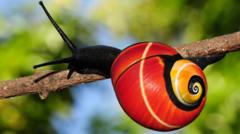Researchers have initiated a vital mission to preserve the strikingly beautiful Polymita snails, an endangered species native to the forests of Eastern Cuba. These snails possess vividly colored and intricately patterned shells, making them attractive to collectors. Unfortunately, this allure is contributing to their decline, as the shell trade significantly threatens their survival.
In a collaboration between Cuban biologists and experts from the University of Nottingham, efforts are focused on conserving the six species of Polymita, with Polymita sulphurosa being the most endangered. This particular species sports a lime-green hue with blue flame patterns and vibrant orange and yellow bands.
Prof. Angus Davison, an evolutionary geneticist from the University of Nottingham, expressed his passion for these extraordinary snails, but he also pointed out the paradox: their beauty poses a significant risk. “The very feature that makes them fascinating to scientists is what endangers their existence,” he lamented.
Research efforts have revealed several online platforms where collectors are selling Polymita shells at high prices, further jeopardizing the species. Prof. Davison highlighted the risks, explaining that the illegal collection and trade of these snails could severely diminish their populations. "With climate change and habitat destruction also posing threats, each shell collected can contribute to local extinctions," he stated.
To combat these challenges, Prof. Davison is collaborating with conservation biologist Prof. Bernardo Reyes-Tur from the Universidad de Oriente in Santiago de Cuba. Reyes-Tur is focused on rearing Polymita snails in captivity, despite difficulties stemming from unreliable power supplies. "It's challenging, but the snails are doing well," he shared during a video call.
Meanwhile, the University of Nottingham has provided well-equipped labs for genetic research. Here, samples of snail tissue are kept in cryogenic freezers for scientific analysis. The goal is to decode their genomes to better understand their evolution, species relationships, and the genetic underpinnings of their distinctive color patterns.
With Eastern Cuba being the sole habitat of these unique snails, the project aims to harness local expertise for their conservation. "We hope that our genetic research will foster initiatives to protect these extraordinary creatures before they are traded into extinction," Prof. Davison concluded.
In a collaboration between Cuban biologists and experts from the University of Nottingham, efforts are focused on conserving the six species of Polymita, with Polymita sulphurosa being the most endangered. This particular species sports a lime-green hue with blue flame patterns and vibrant orange and yellow bands.
Prof. Angus Davison, an evolutionary geneticist from the University of Nottingham, expressed his passion for these extraordinary snails, but he also pointed out the paradox: their beauty poses a significant risk. “The very feature that makes them fascinating to scientists is what endangers their existence,” he lamented.
Research efforts have revealed several online platforms where collectors are selling Polymita shells at high prices, further jeopardizing the species. Prof. Davison highlighted the risks, explaining that the illegal collection and trade of these snails could severely diminish their populations. "With climate change and habitat destruction also posing threats, each shell collected can contribute to local extinctions," he stated.
To combat these challenges, Prof. Davison is collaborating with conservation biologist Prof. Bernardo Reyes-Tur from the Universidad de Oriente in Santiago de Cuba. Reyes-Tur is focused on rearing Polymita snails in captivity, despite difficulties stemming from unreliable power supplies. "It's challenging, but the snails are doing well," he shared during a video call.
Meanwhile, the University of Nottingham has provided well-equipped labs for genetic research. Here, samples of snail tissue are kept in cryogenic freezers for scientific analysis. The goal is to decode their genomes to better understand their evolution, species relationships, and the genetic underpinnings of their distinctive color patterns.
With Eastern Cuba being the sole habitat of these unique snails, the project aims to harness local expertise for their conservation. "We hope that our genetic research will foster initiatives to protect these extraordinary creatures before they are traded into extinction," Prof. Davison concluded.





















